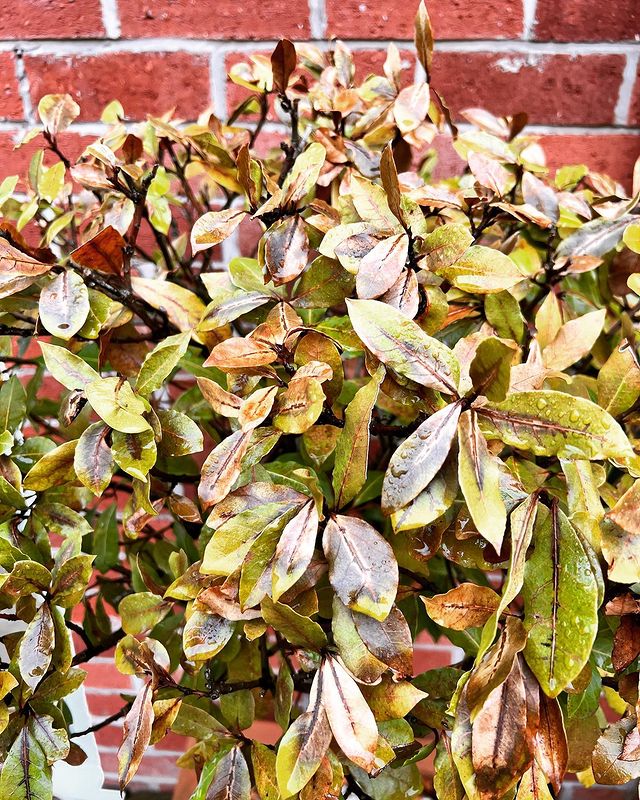Brown leaves on the Bay Tree are a sign of damage, but it does not necessarily mean that you are losing your plant.
You must trim those damaged leaves to avoid diseases and encourage healthy growth.
Although you can’t turn browned leaves green again, you can still fix the underlying issues after reading this article.
Table of Contents Show
Why is My Bay Tree Leaves Turning Brown? [Causes & Fixes]
Your Bay Tree may go to the shock and turn its leaves brown after tolerating strong wind on windy days. But, it may return to its normal state after some days.
Moreover, some leaves may turn brown and fall naturally after aging, but the issue may be serious if they start turning brown in large amounts.
1. Improper Watering
Bay Tree is a Mediterranean plant and will show its stress by turning its leaves brown if you leave it in soggy conditions.
Although Bay Tree is drought-tolerant, too dry conditions may also cause its leaves to turn brown, and gradually leaf fall occurs.

However, if you underwater your Bay Tree during its establishment phase, the plant may die, and the brown and crispy leaves is the initial phase.
Solutions and Preventive Measures
- Water your Bay Tree only when the top 2 inches of the soil becomes dry. Use the bottom watering method for extremely dry soil.
- Use a terracotta container with enough drainage holes and discard excess water on the pot or the saucer.
- Deep watering once a week will be best for the trees stressed with extreme dehydration.
- Water your Bay Trees less during rainy seasons and repot the plant if the soil is extremely soggy.
2. Not Enough Sunlight
Bay Tree loves to thrive in a sunny spot and grows best if you provide more than 8 hours of sunlight daily.
These Plants may not perform photosynthesis in low light or less than 8 hours, making them yellow, and gradually, those leaves turn brown and die later.
Direct sunlight is vital for your Bay Tree but it can also tolerate partial shade. Fully shaded condition is a big no for this plant.
Browning may also occur if you suddenly move your indoor placed Bay plant outdoors after a long time.
Solutions and Preventive Measures
- Place your Bay Tree in a south-facing window indoors and in a sunny spot outdoors, ensuring it receives direct sunlight.
- If natural light isn’t available, place the plant on an incandescent light for 12-14 hours daily.
- Place your indoor Bay Tree outdoors in the winter for more than 6 hours.
3. Nutrient Problems
When you don’t feed your tree correctly, Bay Tree leaves turning brown is a common problem.
Underfertilized Bay Trees will turn their dark green leaves into yellow or light green and gradually turn brown.
Moreover, you will also notice brown leaves with stunted growth in the overfertilized Bay Trees.
For lush growth, fertilize your Bay every three weeks from spring to summer. Don’t fertilize the plant during winter.
Solutions and Preventive Measures
- Fertilize your Bay Tree with all-purpose fertilizer of NPK value 5-5-5, mixing with well-draining soil of pH 6-7.
- Use a soil test kit to maintain proper nutrition and pH of the soil.
- Flush the overfertilized Bay’s roots with distilled water and repot it into a new potting mix.
- Always use distilled or rainwater to hydrate your plant before applying the fertilizers.
- Switch towards homemade compost to provide the best nutrition safely.
4. Cold Damage
Bay is a heat-loving tree that will thrive happily in temperatures ranging from 40-60 °F in hardiness zone 5-9.
These evergreen perennials can tolerate the cold up to 20°F but will be stressed if the temperature declines more.

In severe cold temperatures of less than 20°F, plants may show cold stress by their cracked barks with leaves turning brown.
Although the browned and dead parts will never be as before, the tree will slowly recover after the temperature gets hot.
Solutions and Preventive Measures
- Move your Bay Tree indoors if the temperature is extremely cold.
- If it’s not possible to shift the plant, use frost blankets to protect your plant.
- Mulching around the roots will be best as it maintains the temperature.
5. Pests and Diseases
Sometimes, even if you provide the best environment and feed properly, your Bay may face browning due to different pests and diseases.
One common disease in your Bay Tree is root rot due to soggy conditions. Other pathogenic diseases, like mold, blight, anthracnose, etc., are also responsible for brown leaves.
Insects and pests like spider mites, aphids, psyllids, etc, further spread these pathogenic diseases.
Further, these insects leave awful marks on the leaves. Pathogens are likely to attack and infect the area invaded by insects and pests.
These pathogens spread from one part to another and gradually to other plants infecting the whole garden.
Solutions and Preventive Measures
- Isolate the infected Bay Tree to prevent the spreading of pathogens.
- Prune the infected parts as soon as possible to avoid spreading to other parts.
- To treat root rot, prune the affected root without damaging healthy ones.
- Sterilize the pruning tools before and after use.
- Clear the old debris to avoid fungal and bacterial pathogens on the soil outdoors.
- Apply fungicides and pesticides or neem oil weekly to eliminate pathogens and insects.
From Editorial Team
Don’t miss this to avoid brown leaves on your Bay Tree!
While pruning your Bay, the damaged part may die and turn brown when you accidentally damage some branches.
Moreover, when you apply fertilizer on the leaves instead of applying only on the soil, brown spots may cover the leaves where you have sprayed.
So, avoid these human damages to keep your Bay Tree lush, healthy, and beautiful.


